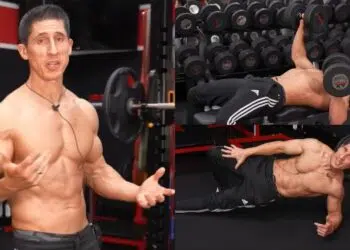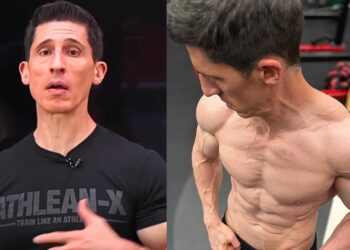Boy, do they come up with some interesting names for exercises these days… although ‘dead bug’ is certainly fitting for this one. When performed, it looks exactly how you’d think it would, on your back with the arms and legs up. But hey, if it works then that’s all that matters right?
It’s a functional exercise for the abs, spine, and lower back that can be done in various ways but the overall idea is the same. We’ve explained how to do this exercise with tips, variations, and how to include it in your training regime.
Muscles Worked/Involved
The dead bug works the core muscles primarily although other muscles are involved in this movement as well.
Rectus abdominis
The term “washboard abs” derives from the lumpy appearance of the rectus abdominis or abdominal muscles. But these sexy muscles are more than just to turn heads at the beach, rather they have the ability to curl the ribs and pelvis toward each other.
Gluteus Maximus
The butt muscles also get some involvement during dead bugs, especially the main gluteus maximus muscles that form a large part of your butt and hips anatomy. These muscles support the extension and external rotation of the thigh where it attaches to the hip joint.
Quadriceps
The quadriceps are an example of muscles involved in dead bugs, however, you’re not going to experience much strength gains. The quadriceps are the muscles on the front of your upper leg and they’re separated by five muscles. The quads can flex the hip joint and extend the knees too of which you’ll see both of in the dead bug.
Level Up Your Fitness: Join our 💪 strong community in Fitness Volt Newsletter. Get daily inspiration, expert-backed workouts, nutrition tips, the latest in strength sports, and the support you need to reach your goals. Subscribe for free!
How To Do The Dead Bug
Alright now for the fun part… performing the dead bug.
- Lie on your back with your knees bent and feet on the floor and arms down by your sides.
- Lift your feet off the ground until your upper legs are vertical and your lower legs are parallel to the floor. Both your knees and hips should be at a 90-degree angle.
- Exhale and make sure that your lower back is flat on the floor throughout the exercise.
- Extend one leg forward until your foot is within a few inches from the floor. Bring your leg back to the starting position and repeat with the opposite leg.
Here’s a video example…
Dead bug exercise tips
- Change up the movement by moving your arms overhead while extending the legs forward at the same. Feel free to perform any combination that you can do safely.
- If you have tight or weak hip flexors, you may have to take care of that before doing this exercise as it can cause pain and injury by forcing the movement.
- To make the exercise easier especially if you have limited hip range of motion or mobility; keep your leg/s higher off the ground at first and then gradually lower it little by little.
- To make the exercise more challenging, use ankle and wrist weights or lower both arms and legs at the same time. You can also alternate lowering the one arm and the opposite leg and repeating this pattern.
Variations/Alternatives
Here are some variations/alternatives that you can do instead of the dead bug, that are similar.
Level Up Your Fitness: Join our 💪 strong community in Fitness Volt Newsletter. Get daily inspiration, expert-backed workouts, nutrition tips, the latest in strength sports, and the support you need to reach your goals. Subscribe for free!
Straight leg raise
For this variation, you’re going to keep the legs fully extended as you raise your feet toward the ceiling and lower them down. But the key to this exercise is to avoid arching the back. So you don’t want to allow a space between the back and the floor.
Cocoons
Cocoons are yet another very interesting name for a bodyweight core exercise but it’s going to activate more of the muscles of the midsection. It’s also more challenging by the same token as the upper and lower body are involved to the same degree.
Here’s a great video on some of the best progressions and regressions exercises.
How To Incorporate The Dead Bug Into Your Training Regime
The dead bug is a core exercise and therefore, should be included any time you train your midsection muscles. For example, when you’re performing crunches, leg raises, or any other effective abs and core movements.
Sets/reps
2-3 sets of 15-25 repetitions is a good range to stick with for this activity. If it becomes too easy to where you can complete endless repetitions, consider doing a more challenging variation.
Related: Try This Beastly 30-Day Core Workout To Get Jacked and Strong
Wrapping Up
The dead bug core exercise certainly has benefits whether you’re a beginner or more advanced exerciser. If you want to be functional, stronger, and better at your heavier compound lifts, athletic activities, or daily chores, this is a great exercise to incorporate into your training regime.
Interested in measuring your progress? Check out our strength standards for Hanging Leg Raise, Crunches.








